The piece of the month of November 2015
A TERNO "ANGELIQUE" IN THE PARISH OF SAN PEDRO DE PITILLAS
Alicia Andueza Pérez
PhD in History of Art
In the Navarrese parish of San Pedro de Pitillas, a terno of special interest is preserved, both for its peculiarity and richness and for its origin. This set, consisting of a chasuble, two dalmatics, a pluvial cloak and various accessory pieces, can be identified as one of the ornaments known as "angélique" - due to its iconography - which were made at the end of the 19th century and beginning of the 20th century in the French city of Lyon.
design In 1888-1889, the artist Joseph-Alphonse Henry (1863-1913), whose workshop specialized in the manufacture of sacred vestments, commissioned the painter Gaspard Poncet (1820-1892), an artist who is documented to have made numerous designs for stained glass, mosaics or goldsmith pieces, to design a chasuble. The first copy of this chasuble was made in 1891 for the then Archbishop of Lyon, Cardinal Foulon, but in 1894 J.A. Henry presented a copy, in this case not woven but embroidered, at the exhibition Universal, International and Colonial of Lyon. Given the success of the "angélique" chasuble, the artist was asked to complete the tern with the remaining pieces. These were also made according to Gaspard Poncet's design , but it was not until 1897 that the two dalmatics and their accessories were made. A year later, the cape model was finished and the artist presented it at the 1900 Paris Universal exhibition , where it was decorated with a Grand award.
This ornament enjoyed great success and was marketed by the workshop of J.A. Henry and later by his successors, J. Truchot et Grassis and J. Truchot et Cie, until the Second Vatican Council. Some embroidered pieces were made but most are woven, as is the case of the terno that concerns us here. Several examples of this ensemble are known in various French churches, such as the cathedral of Saint-Jean-Baptiste in Lyon or the church of Sacré-Coeur in Amiens. Some of these garments are also treasured in the Musée de Tissus in Lyon, where the preparatory drawings made by Gaspar Poncet for the dalmatics and for the chasuble, both in their French and Spanish forms, are also kept.
As we are informed by the Catalog of works of the Musée de Tissus de Lyon, the different garments of this set were made on a loom subject Verdol and are formed by a lampás of satin background interwoven in crimson silk and gold threads. The lampás or lampazo is an elaborately worked silk fabric in which two sets of warps and wefts are used, and which, as can be seen in this set, stands out for the effects of brightness and Issue achieved in the decorative motifs.
The different garments carry a very meditated and significant iconographic program, like a canticle woven in silk and gold to the glory of the Son of God as Master and Savior. The different scenes that are narrated are accompanied by a phylactery supported by angels with inscriptions related to the passages that are represented. As for the chasuble, the front part presents an image of the Virgin and child around which numerous angels playing instruments and singing praises are arranged, while on the back panel, the apostles and the Virgin observe the Ascension of the Lord to heaven where he is received by God the Father and the Holy Spirit. In the lower area, we find the legend that alludes to the designer and maker of the garment: "GASPARD PONCET, MDCCCLXXXXXIX, J.A. HENRY".
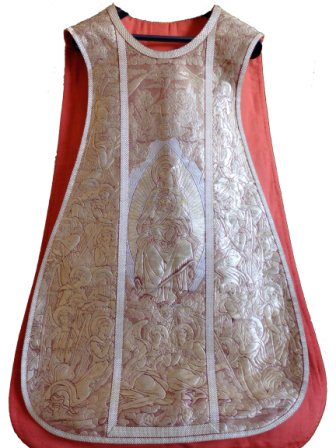
Chasuble with the Virgin and Child on the obverse side
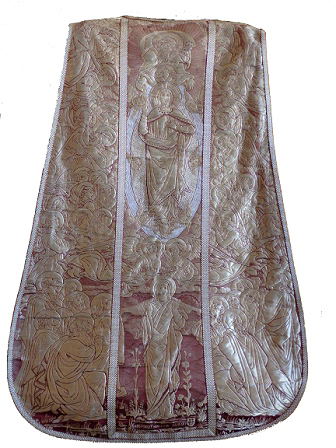
Chasuble with the Ascension of Christ on the reverse side
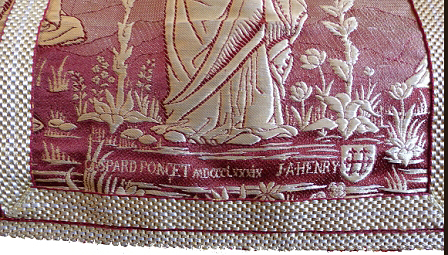
Detail of the chasuble with the names of the authors and the date
Regarding the dalmatics, one of them shows the scene of the Nativity, the Adoration of the Shepherds and the Adoration of the Magi, and the passage of Jesus among the Doctors. The cuffs, on the other hand, are decorated with motifs and legends related to the Eucharist. In the other dalmatic, the scene of the submission of the keys to St. Peter and the entrance of Jesus in Jerusalem are represented on the skirts, with the architecture of the eternal city as a background. As in the other garment, the sleeves also bear Eucharistic motifs.
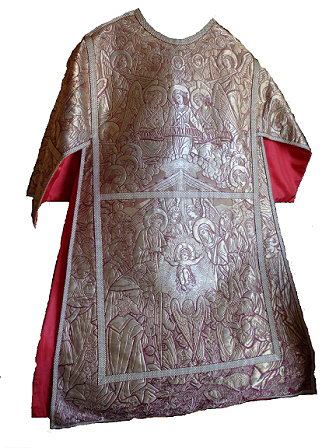
Dalmatics with Epiphany
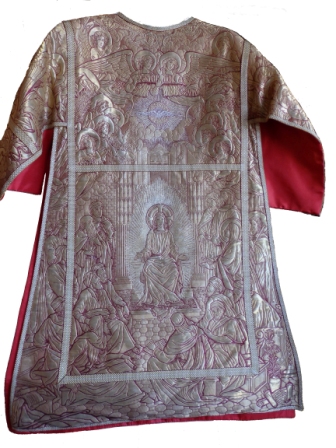
Dalmatics with the scene of Jesus among the doctors
The pluvial cape is the richest and most complex piece in its design of the whole ensemble. In the border that surrounds it there are different Marian attributes taken from the litanies of the Lauretan litanies, while the hood contains the Coronation of Mary by God the Son, God the Father and the Holy Spirit. Above the hood and in the area of the border that includes the collar, a legend puts an end to the iconographic program: Unus est Deus in reference letter to the Holy Trinity. The entire flight of the cape is also filled with figures of saints with their attribute and their name in the nimbus, which are arranged around the Holy Women, the apostolic high school and the legend: Vivent in aeternum. Underneath the hood, a registration alludes to the extraordinary award that this garment received at the 1900 Paris Universal exhibition .

Rain cape with the Coronation of the Virgin on the hood
Rain cape. Detail under the hood
The various garments stand out for the complexity of the compositions and the numerous characters that are arranged in a kind of horror vacui. The stripes, which traditionally frame the various passages in the most marked areas, do not interrupt the narratives, but are superimposed on the fabric as retorchas. The figures, executed with great naturalism, adopt different positions and attitudes, all of this from agreement in the historicist style typical of the period, which looked to past styles as source of evocation and influence.
As we are informed by a registration sewn inside one of the dalmatics, this set arrived at the parish of Pitillas in 1907. It was a gift made by Bishop José Cadena y Eleta, a native of this town, so that it could be used in the first masses of the young natives of the town who were to be ordained priests. This bishop, who came to occupy the primate see of Segovia, Vitoria and later the archbishopric of Burgos, was noted for carrying out an important role as a patron of the arts. He promoted works wherever he was and especially benefited his native town, where he supported, for example, the construction of the high school of San José, the operation of which he entrusted to the Daughters of Jesus. The liturgical ensemble analyzed here is test of the taste for the arts of Bishop Cadena y Eleta since, in spite of being a serial ornament made on a loom, it stands out for its singularity, its richness and its careful iconographic program.
